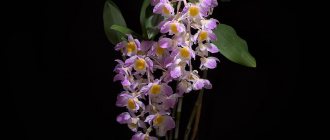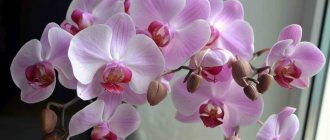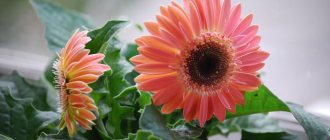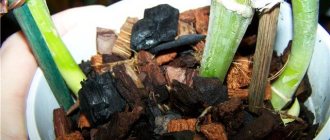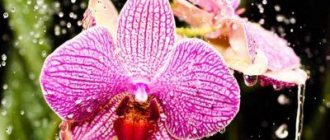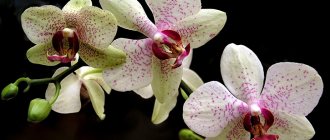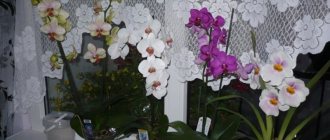Dendrobium (epiphyte) is a representative of indoor orchids. It is loved for its beauty and easy cultivation. The plant grows actively and blooms profusely in properly selected soil. From the article you will learn how to prepare it.
Planting/growing
A plant purchased in a store does not need to be replanted for at least 2-3 years. With proper care and feeding, both the pot and the substrate in which it is located will last for several years. Dendrobium prefers a cramped container, so it is better not to rush with replanting, as in principle with any orchid; the less we disturb it, the stronger and healthier the plant. If you still decide to replant the plant ahead of schedule, you can use pine bark as a substrate. The flower endures this process extremely painfully, so it is carried out as rarely as possible.
Phalaenopsis dendrobium is transplanted into a small plastic, ceramic or clay pot. It is desirable that the color of the pot be light. For good air circulation, light access and to prevent root rotting, it is recommended to make small holes throughout the container. A drainage layer must be placed at the bottom of the pot. Crushed brick, crushed stone, and foam are perfect for this.
Next, the soil mixture is laid. It cannot be compacted; the soil must be loose. But the plant must be securely fastened in the pot. To do this, you can put several pieces of broken brick on the bottom or carefully secure the plant with wire. After the flower is planted, you need to spray the leaves and top layer of soil with water from a spray bottle.
In order to understand whether the phalaenopsis dendrobium needs replanting, you should evaluate the condition of the soil, the above-ground part and the root system. Replanting will definitely be needed when the substrate begins to rot, thereby causing damage to the roots and shoots. If the soil begins to crumble and stops absorbing water, then it’s time to change it. If the roots do not have enough space in the pot, you should immediately start replanting. Otherwise, the plant may simply die. As a rule, a planned transplant is carried out once every 2-3 years.
Before starting the procedure, you should stock up on fresh substrate, a new pot and tools for removing rotten parts of the root system, which must be disinfected. Remember, the roots of an orchid are very fragile, so you need to act slowly and carefully. After removing the faded orchid, you should carefully remove the old soil. To thoroughly clean the orchid roots, you should rinse them under warm water.
Before transplanting, you should carefully examine the flower for the presence of parasites and diseases. Next, you need to dry the plant for 8-10 hours. The bottom of the new pot should also be treated with an antiseptic. Transplantation is carried out only after flowering, but preferably not during the dormant period. The best time for transplantation is traditionally spring.
The soil mixture for orchids is unusual. The soil composition includes bark, sphagnum, peat, and charcoal. Specialized stores sell ready-made substrate, but you can prepare the soil yourself. When preparing the soil yourself, it is important to remember the need to disinfect its components. The bottom of the pot is lined with crushed stone or broken brick. This is necessary to create a drainage layer. It is recommended not to use expanded clay and limestone, as orchids do not tolerate them well. Bark is laid on top of the drainage layer, then peat. Peat has the acidity needed for dendrobium. The choice of pot is also very important. It is better to give priority to clay containers. The container should not be too large. There should be no more than a couple of centimeters between the wall of the planting container and the roots of the plant.
How to properly care?
A distinctive feature of dendrobium is that it has a dormant period . After it finishes flowering it appears to stop growing, this is not the case, in fact it goes into a dormant period. In this case, watering is reduced to a minimum. It is also better to keep the temperature quite low, around 17-21 degrees. After dormancy ends, the plant begins to grow new shoots.
Dendrobium blooms as continuous bushes when neither pseudobulbs nor leaves are visible. It may seem like they are just balls of flowers. An interesting feature of this plant is the presence of so-called children. If the dendrorium blooms at the wrong time and the babies grow on the pseudobulb, this is a sign that the care is not being carried out correctly.
Sometimes the dendrobium can take root above the ground , in which case nothing needs to be done. If you sprinkle soil on top, the plant may stop growing.
Care
With proper and competent care for dendrobium phalaenopsis at home, the plant will delight you with its beautiful appearance for up to 8 years. Of all the varieties of orchids, dendrobium phalaenopsis is the most unpretentious and hardy, so it is perfect as a pet for beginners who have no experience in growing this type of plant.
The main feature of the flower is the ability to adapt to any climatic conditions. The plant loves light, but does not tolerate direct sunlight, so the ideal place for it would be on a windowsill facing southeast. If the dendrobium phalaenopsis is located on the windows of a southern landmark, then from the second half of March you need to make sure that the bright sun does not harm the young shoots and be sure to shade it with a light curtain at noon. Aluminum blinds can be used, but you need to be careful; misdirected slats can also reflect the flow of light and cause thermal burns to both bulbs and leaves. In winter, it is recommended to use additional lighting to stimulate plant growth.
Dendrobium should be sufficiently lit. The color of the leaves will tell you whether the plant has enough light: bright light green indicates an excess of light; dark green ones “report” that the flower is lacking light; yellow ones appear in very poor lighting; an even green tint indicates that the plant is receiving enough light.
Air temperature is not particularly important for this plant. It can feel great both at +10°C and at +42°C, since in its natural environment it has to adapt to different temperature conditions. During the period of active growth, it is advisable to maintain the daytime temperature around 20-26°C, and at night - 15-20°C. At this time, the orchid will benefit from being outdoors - on an unglazed balcony, veranda or in the garden. The natural daily temperature difference is necessary for active development, the formation of flower buds and lush flowering in winter. The second feature is that for winter flowering, dendrobium requires a period of rest from the beginning of November to the end of December.
An important condition for good growth of phalaenopsis dendrobium is an average level of air humidity. Dendrobium comes from tropical forests with high humidity, reaching 55-60%. Therefore, it is advisable to create conditions for him that are close to natural. The plant loves to be sprayed with a spray bottle. It must be carried out daily, using soft, settled water with a minimum content of chlorine. Spraying can be carried out both to increase air humidity and clean leaves from dust, and for the purpose of surface feeding. Only the upper part of the leaves should be sprayed with water to avoid disruption of gas exchange.
To maintain the required level of humidity, you can place moss in the orchid pot or place a container of water next to the pot. Humidity is maintained around the plant, but not in the room itself. An environment that is too damp promotes the growth of bacteria as well as fungi. Under such conditions, the orchid will be at risk of infection.
Watering the plant should be done as the soil dries. In summer and spring, it is recommended to moisten the soil more often than in winter and autumn, since the frequency of watering directly depends on the temperature and dryness of the air. The higher these parameters, the more abundantly and more often watering is required. Take warm water at a temperature of 35-40 degrees. It is better if it is water from a hot tap or heated distilled water.
In order for the roots of the plant to be better saturated with moisture, many experts advise, instead of the usual watering, to place the potted plant in a pan filled with water for about half an hour. You can add fertilizer in the recommended proportion, then wait for the water to drain. It is important to allow the liquid to drain completely to prevent water stagnation in the root system.
The frequency of watering can range from once every 2-3 days to once every 20 days. In order to check whether it is time to water or not, experts recommend this method. You need to take a wooden stick and stick it into the pot until the very end. If the stick is dry, then it’s time to water the plant; if it’s wet, then it’s time to wait.
In order for the plant to feel good, during active growth it needs to be fed every 2-3 waterings. For this, special fertilizers for orchids are used, which can be found in any flower shop. Regular fertilizers for flowering plants will not work here. The recommended dose is half the amount indicated on the package. When fertilizing, carefully monitor the condition of the flower, since if it is oversaturated with fertilizer, it may darken and dry out.
Caring for Dendrobium Phalaenopsis after flowering is somewhat different from usual. This is necessary so that the plant blooms again as soon as possible and pleases you with its incredible exotic flowers for as long as possible. The main condition during this period is to stop watering. You need to get rid of the old peduncle by carefully cutting it with scissors. It is not recommended to completely cut off the stem, because it is in this part of the plant that nutrients accumulate, which contribute to the further growth and flowering of the orchid; The resulting wounds should be thoroughly treated with a mixture of charcoal and ground cinnamon. Many beginners skip this stage, but this can lead to the death of the plant.
Next, you should put the flower in a cool place. It is better if it is a slightly darkened sunny place, since darkness can cause the plant to go into hibernation, which is characterized by a complete cessation of growth. At this time, the flower does not need regular watering, but the optimal climate must be maintained in any case. You should also be careful when using various fertilizers. You need to water the flower only when the soil dries completely.
To summarize all of the above, the conclusion is that there are several basic rules for caring for dendrobium phalaenopsis at home: protecting the plant from drafts, direct sunlight and excessive watering. As practice shows, even inexperienced flower growers are quite capable of following such simple recommendations.
What soil is needed for dendrobium?
It is better to purchase a special substrate for this orchid at a flower shop. Before planting the plant, the soil must be disinfected, for example, soaked in a solution of potassium permanganate or boiled. Composition of soil for transplanting dendrobium:
- Drainage - small stones or clay shards.
- Moss - sphagnum is required to maintain normal humidity levels.
- Flat pieces of foam so that the soil mixture allows air to pass through well.
- Large bark, which is most often laid on the lower drainage layer.
- Fine pine bark, which is used to create the main soil mixture.
Reproduction
Dendrobium phalaenopsis is propagated vegetatively: by dividing the bush and cuttings. The shoots are separated along with the roots and placed in a separate container and watered. This procedure is quite painful for the plant. In addition, if you choose this method, you should not count on flowering in the near future.
Usually, after the phalaenopsis dendrobium has bloomed along the entire height of the mother pseudobulbs, children may appear. As soon as they grow and the length of their roots reaches 5-7 cm, they are carefully separated with a knife and the cut site is sprinkled with coal. It may happen that the children, just like an adult full-fledged bulb, can release buds and bloom in small quantities due to the forces of the mother plant. In this case, you need to wait until they bloom, and only then separate them from the pseudobulbs.
Then we take small plastic pots and prepare the substrate for planting. As planting material, you can use mostly fine pine bark and, to a lesser extent, in equal parts: small pieces of charcoal and sphagnum moss. We mix all this and plant the shoots without deepening them into the substrate.
At first, you need to provide young plants with high humidity. It is recommended to spray only the upper part of the substrate, avoiding the stems in order to prevent them from rotting. Watering should be regular. The soil mixture should always be moist, but you need to ensure that the water does not stagnate in the pot. Only three weeks after the young plants have become stronger can you begin to feed them with complex fertilizers.
In the case of cuttings, the procedure is carried out as follows: the pseudobulb is separated from the bush and cut into cuttings of the same length. Each cutting is placed in cellophane with moss inside until roots appear. In order for the roots to begin to form, the moss is regularly moistened and the cuttings are ventilated. The cuttings will take root after 15–20 days, after which they can be planted in separate pots. The bushes grown from them will bloom for the first time after 2 or 3 years.
Step-by-step technology for transplanting plants by waddling
The transshipment method is carried out quite rarely . The most common reason is replacing a flower pot with a larger one, due to the growth of the root system.
There are different methods of transplantation, one of them is the transshipment method.
The principle is that the root ball is not destroyed, but is carefully removed and transferred to a new container. There is virtually no complexity in the process.
The main thing is accuracy, since sometimes, out of vital necessity, even a flowering plant has to be replanted in this way .
Preparatory operations:
- Choose a flower pot that is 20-30 mm wider than the previous one;
- Disinfect it with a solution of potassium permanganate;
- Prepare a new substrate and inert components;
- Prepare and disinfect available tools (scissors, knife, wooden stick, bamboo support).
Step-by-step instruction:
- We water the root ball in advance for safe removal;
- At the bottom of the new container we place heavy pebbles and drainage made of inert materials a couple of centimeters thick;
- Carefully turn the pot over and try to remove the root part without disturbing the soil ball with roots. If necessary, cut or break the old container;
- Place the orchid in a new pot;
- Empty and free areas are filled with new substrate, carefully compacting them with a stick;
- We install and secure the bamboo support with clips.
Important! When filling with new substrate, you must ensure that the roots do not bunch together.
Pests and diseases
It is necessary to care for the orchid especially carefully. Competent and proper care helps the owner of the flower to make the life of the orchid prosperous and blooming in the literal sense of the word. If maintenance rules are violated, the appearance of diseases and pests is inevitable.
Dendrobium phalaenopsis, unlike other types of orchids, is a very unpretentious plant with a strong, hardened character. The lack of flowering, as well as problems with roots, are primarily due to improperly organized care. The reason for the falling of buds can be drafts, as well as an ill-selected substrate.
The most common problem for this species is root rot, which is primarily due to excessive watering, stagnation of water in the pot and lack of air circulation in the roots. Overmoistening causes not only rotting of the roots, but also wateriness of the pseudobulbs, which cannot produce flowers. Such an orchid will multiply foliage without creating new flower stalks.
Very rarely, dendrobium is affected by spider mites, aphids or thrips. It is necessary to increase the humidity around the plant, wash it once every two weeks with soapy water. Remove parasites; in case of severe damage, treat the leaves with an insecticide. In the case of fungal disease, the problem most often lies in excessive watering. The flower is saved by transplanting into fresh soil. The roots are carefully inspected before planting in a new soil mixture. Remove rotten parts affected by fungus. Healthy roots are treated with charcoal and dried. Water the orchid 10 days after transplantation.
Favorable growth and flowering depends on the care of phalaenopsis dendrobium. It should be as close as possible to the natural habitat. Proper maintenance will provide the plant with buds within a few months, which will delight its owner with beautiful and fragrant flowers. If you follow certain rules and recommendations, your efforts will not be in vain. the plant will definitely thank you with the exquisite beauty of its flowers.
| Growing | The plant loves a lot of light; at night the temperature should be 5-7 degrees lower than during the day. |
| Humidity | Moderate 50-60%, low is also allowed, spraying is not recommended. |
| Feeding and pruning | From February to August, the plant needs to be fed at every second watering, from October to February once a month, during the flowering period it is not necessary to feed, and does not need pruning. |
| Flowering period | Blooms in spring and winter. |
| Landing, transplant | Replant after flowering once every two years. |
| Reproduction | The plant reproduces vegetatively by dividing the bush. |
| Pests | Spider mites, aphids, thrips. |
| Diseases | Root rot. |
Features of the view
The Dendrobium orchid is an epiphyte , and the most charming ones are considered to be its homeland in the islands of Polynesia, South Asia and Australia. Among the huge number of beautiful orchids, it is difficult to confuse this plant with another species. When an orchid blooms, its trunk is practically invisible; it is all densely strewn with graceful flowers.
Two main features of Dendrobium can be distinguished:
- root system is white;
- the stem is erect, pseudobulbs are formed from it.
ATTENTION : This representative of the Orchid family has one not very positive feature - one shoot grows and blooms well for 3 - 4 years, and then dies. You just need to be prepared for this and try to start breeding your handsome dog as early as possible.
Related Issues
Of course, even with the most ideal care, problems cannot always be avoided. The main problem is the reluctance of Dendrobium to bloom; there may be several reasons:
- overdid it with fertilizers;
- the plant does not have enough light;
- the air temperature is incorrectly selected;
- air humidity is too high;
- a delicate flower will never bloom in the room of a heavy smoker.
Another problem is that the color of the shoot suddenly turns brown or yellow, this is due to excessive watering, the roots begin to rot. Sometimes, instead of flower buds, children begin to grow, which means you need to stop watering the plant for a while and move it to a more illuminated place. Read about why the leaves of the Dendrobium orchid turn yellow and how to deal with it here.
Photos of varieties
Next in the photo you will see the Dendrobium varieties Dendrobium phalaenopsis (Dendrobium phalaenopsis) and Dendrobium nobile (noble or nobile):
"Dendrobium phalaenopsis"
"Dendrobium nobile"
